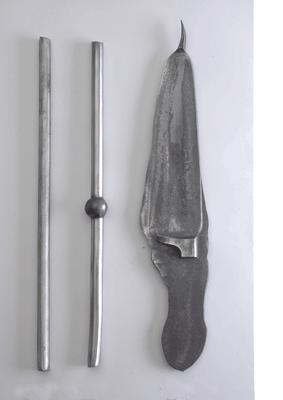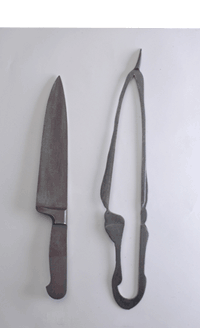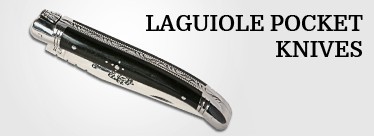- History
- Technical Questions
- To know a Laguiole
- Laguiole upper parts details
- The bladestop
- From steel bar to knife
- Closing systems for pocket knives
- How to sharpen your knife ?
- Sharpening stones
- Unkeep of folding knives
- Upkeep of your kitchen knife
- Cutlers adresses
- Stainless steel and carbon knife
- The art of shaving with the straight razor
- Upkeep of straight razor
- Materials
Stainless steel and carbon knife

Making a forged stainless steel and carbon kitchen knife
To be classed as a forged knife, the knife must be made out of a single piece of steel and entirely forged (blade, bolster and tang).
Forging works the steel fibres, resulting in a better cut.
To ensure the optimal cutting edge, special stainless steel, with a high carbon content is chosen. (C50C13) 
The blade is the most important part of a kitchen knife.
In 'false' forged knives (where knives are soldered or semi-forged), only the bolster is forged. The blade is made out of a single piece but not forged.
1 Forging
Bands of steel are cut into billets, carefully calculated to conform to final specification of the knives.
These are then heated to 1150° centigrade to enable the process of hot forging to take place.
The red hot billets are carefully placed under a very strong drop hammer in a 3-part mould which exactly corresponds to the size of knife which is being produced.
Three hits or blows of the massive drop hammer are needed, one in each section of the mould, to forge the billet into the require shape. 
Showers of sparks accompany this operation :
After forging the knife is returned to the furnace and heated to 800° C. This makes it malleable once more, in order to trim the rough shape to the form required.
The handle or tang is then pierced with exacting precision so the rivets can be mounted to the handle.
2 Tempering
Tempering gives hardness to the knife to ensure a long lasting cutting edge. It is a very important operation.
First the knife is dressed (straightened) to prevent excessive warping during the tempering process.
The knives are carefully placed in special trays. They are put into the furnace at 1060° centigrade.
After an exact calculated period of time at these high temperatures, the knives will be placed into a machine which allows them to be straightened during the cooling time in order to prepare for the grinding operation.
Every knife must be put back into the furnace to reheat it and "return" hardness to the steel (200°-300° C).
After this reheating process the knives will have a hardness of 54-56 Rockwell, that is to say the re-sharpening of the blade will be easy with a sharpening steel or stone. If a knife is too high on the Rockwell scale it is difficult to sharpen and becomes brittle.
3 Grinding
The blade of the rough knife is ground to give the best cutting edge. This operation is called "Grinding"
Sabatier K invested in the best Grinding machine (Berger - German).
With it the grinding of the knives is perfect and of an exceptionally high quality.
Finally, the back, bolster and tang of the knives will be worked.
Several milling tools of different shapes and angles are then employed to mill the rest of the knife to a fine finish.
4 Assembling the handle

The two parts are individually matched to the tang, and drilled in order to assemble the handle.
5 Final polishing
After all the above processes are finished, the knives must now be given their polish. This operation is called "Final polishing".
Many different shaped tools are used in this final polishing process. You can also use polishing tools that take less space.
All production marks are removed giving the knife blade its final unique satin finish.
Finally, the blade is ready to be re-sharpened on a whetstone and stamped with the Sabatier K trade mark.
Before each knife is packed it has to be reinspected to be positive it meets the standards of excellence which is deserving of the brand Sabatier K.
Once this is ascertained the inspector covers every blade with a protective sleeve and it is ready for be packed. 
Each knife is then wrapped and packed for final shipping.
Discover our range of table stainless steel knives








